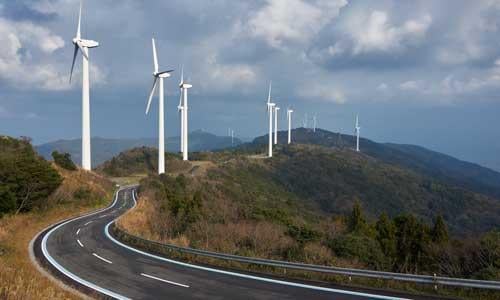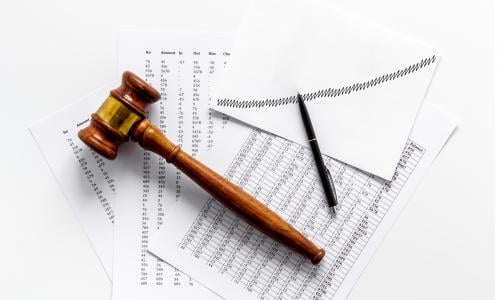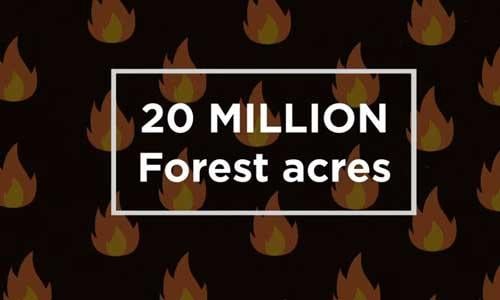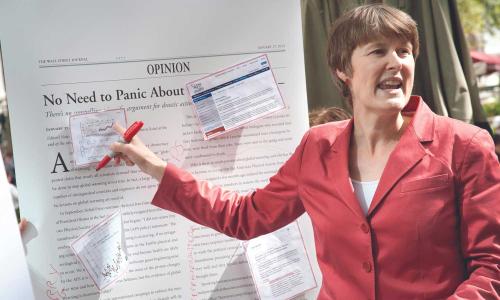How much do you know about nuclear power? Dr. Edwin Lyman, internationally recognized expert on nuclear proliferation, walks us through nuclear power, its associated risks, and small modular reactors.
In this episode
- Ed talks about safety concerns related to nuclear power
- Colleen asks what a small modular reactor is and how safe they are
- Ed and Colleen discuss terrorism risks when dealing with nuclear energy
- Ed talks about how well nuclear power competes with other energy types
Related content
Full transcript
When we talk about our country’s transition to a clean energy economy, we tend to speak in terms of renewable energy, like wind and solar power, pitted against non-renewable fossil fuels like natural gas, coal, and oil. That’s because there’s undeniable momentum for renewable energy from coast to coast. But there’s another sector of energy production, of course, and that’s nuclear power. To me, nuclear energy is sort of like your weird intense cousin who comes to family parties once a year and doesn’t talk to anyone. Even though nuclear-generated power is responsible for about 20% of the energy produced in the US each year, it’s not often at the top of my mind.…until an accident like Fukushima happens.
One of the reasons we forget about nuclear power is that it’s becoming less competitive these days, with prices dropping for natural gas and for renewable energy. This has resulted in a lot of nuclear plants closing, and a lot of power being taken offline. Five American nuclear power plants have closed in the last five years, and five more are slated for retirement in the next ten years.
The Trump administration has proposed artificially propping up certain plants to keep them competitive, but is that really a sensible option? What does the nuclear power plant of the future look like? Should we invest in smaller nuclear reactors? Should our clean energy economy factor in nuclear power at all?
To get answers, I sat down with my colleague Ed Lyman, senior scientist at UCS, and an internationally recognized expert on nuclear power safety and security, and on nuclear proliferation and terrorism. We chatted about the potential drawbacks of new nuclear technology called small modular reactors… why the nuclear industry needs to be well regulated… and why you really don’t want to go swimming in a spent fuel pool.
Colleen: Hi Ed, thanks for joining me on the Got Science? Podcast.
Ed: Thanks, it's great to be here.
Colleen: So, I wanna talk about nuclear power reactors, and specifically the proposed small modular reactor that I believe is referred to as the SMR. Can you start off by telling us what they are?
Ed: Sure. Small modular reactors are characterized in two ways. One, the fact that they're smaller than the conventional nuclear reactors that are being used today. So, if a conventional reactor typically generates, about 1,000 or 1,100 megawatts of electricity, the small reactors typically would be 300 megawatts or less. So, about a third or less of the size of a conventional reactor.
Colleen: So, just to give our listeners...would that be like a 12 by 12 cube, or does that matter what the physical size of it is?
Ed: You know, the physical size is not completely correlated with the amount of electricity it generates. So, it's hard to give a general response to that, but typically they could be smaller or even much smaller. But the footprint of a nuclear reactor isn't really determined by the nuclear fuel in the core, which is what will really determine the power that's capable of being generated, but more by the other aspects of the plant like a containment building which is meant to prevent the release of radioactivity in the event of a core melt accident, and the other auxiliary building.
So there's a lot of leeway for addressing the reactor footprint that's not completely correlated with the size.
Colleen: And the idea is they're just...I mean they're smaller in that they can be manufactured more easily?
Ed: Yes. So, the other part of SMR is the M, which is modular. And the philosophy is instead of building one massive reactor to generate base load power which is inflexible and can't follow demand very easily...and these days utilities want more flexibility. They don't wanna buy huge chunks of power, and nuclear reactors can't be turned on and off very easily. So, you're kind of stuck with this large amount of base load power as long as they're operating.
The idea would be to have smaller reactors that you could add incrementally so that there's the modular aspect that you would essentially snap them together like Legos. Not exactly but that's the idea conceptually. And they could be conceivably manufactured in a factory on an assembly line where they would be standardized.
These factories would crank out hundreds or thousands of units a year in the dreams of some of the vendors, and they could achieve more efficiency and economy by standardizing the manufacture. That's the theory.
Colleen: So, talk a little bit about then, the economics of that, because it doesn't really work when you lay it all out.
Ed: Yes, the challenge that nuclear power is facing today in The United States is economics. And the fact that the price of fossil fuels and natural gas has decreased dramatically when the price of generating nuclear power hasn't. And so nuclear power is having a harder and harder time competing, and that's the existing operating plants that have in most cases already paid off all their debts.
So, they're really just running at the cost it takes to operate them. So, the main thing to realize about a smaller reactor is that generally, it'll produce more expensive electricity than a larger reactor. And that's because of the economies of scale principle. Over the history of nuclear reactor development they started off fairly small, but they grew larger over time. And the reason for that is because building a larger reactor generally will produce less expensive electricity than a smaller reactor because of the economies of scale principle.
So, if you go in reverse and you shrink them, then you're dealing with a potential cost premium compared to large reactors. And so, since the large reactors are not competitive today, these small reactors may be even worse on a, you know, per unit of electricity generated. So, that's the challenge that these reactors are facing.
Colleen: Where would these small modular reactors be sited? will they be handled in the same way as large power plants or will they be dispersed, in a wider range?
Ed: I think that all the potential options are being discussed. You could have a number of small units all operating together in one site. So, essentially instead of building one large plant, you build... as I said before, you'd supply smaller units, perhaps they'd be added as needed.
So, you would just be replacing a large reactor with many small reactors, but some of the vendors are also looking at the possibility of dispersing or distributing these units more widely. So, for instance, at sites where there are coal plants that are shut down or may be shut down soon, perhaps you could replace that coal plant with a small modular reactor.
And then at the extreme, some of the designs being contemplated are very small, maybe 10 megawatts of electricity, and they might be used to provide small amounts of electricity to remote areas, to military bases, places where there isn't a grid that can handle a large amount of electricity.
So, there are a lot of dreams about how these would be deployed.
Colleen: So, and each of those would need all of the safety containment, so it seems like that would be even less economically feasible.
Ed: There are a lot of unanswered questions about how these designs would be regulated, and until those questions are answered, it's really hard to make any judgments about whether these plants will be safer. The vendors who hope to sell small modular reactors generally make the claim that these reactors, first of all, they're going to be smaller. So, each unit will have a smaller amount of radioactivity that could be released in the event of a severe accident.
And second, they argue that they're going to have inherent safety features which will make them less risky, so the possibility of having an accident in the first place that would lead to fuel damage is smaller. So, putting those all together, they claim the reactor's gonna be so much safer that they don't need a lot of the safety and security features of the current fleet.
And that's when it gets complicated, because if you say our priority, the reactor's gonna be safer, so therefore we don't need extra safety features, until you figure it out, the sum total of all the changes you're gonna make, you don't know if they're gonna be safer than the current generation.
Colleen: So, do you have an example of a particular feature that they're talking about that you think may work or wouldn't work?
Ed: One of the big concerns... Because small modular reactors are a priori more expensive, the vendors are looking to make all sorts of design compromises to cut corners to reduce the capital cost and operating cost even further. And there are a lot of ways where you can cut corners. One is in the size of the containment building that nuclear reactors are required to have to protect the environment in the case of an accident like Fukushima, where the core melted and radioactivity was released.
Now, Fukushima could have been a lot worse if those reactors didn't have some sort of containment. But the containments that those reactors had were not adequate to prevent any radiological release, and that's why there's still a large area in Japan which is off-limits to human habitation.
So, ...but the containments generally are expensive, they're large steel reinforced concrete buildings, they're often a large fraction of the capital cost of the plant. So, it's a place where SMR vendors would love to cut. And of course, if you built the same large containment over each small reactor, then it clearly wouldn't make sense to replace one large reactor with multiple small ones. So, it almost doesn't make sense to do that, but the question is, is it really going to be safe enough to compromise on the containment.
There's another important aspect which is the quality assurance that goes into the manufacture of nuclear components. Generally, nuclear power plants, because of the potential risk of an accident, have to be manufactured to very high-quality assurance standards. That is you make sure that the materials are very high-quality, that they're consistent, that they're constructed with very rigorous standards, and that is also something that adds to the cost of nuclear plants because it slows things down, it limits the number of suppliers that can supply these materials, it requires a lot of paperwork.
So, the vendors would love to cut the use of what's called, nuclear safety grade equipment in construction. And again, they argue that because the reactor's gonna be safer, they don't need to make those very critical standards. And that's something that we worry about a lot because when you start saying, "We don't need to build a nuclear reactor with the highest safety standards," we think that that is jumping the gun because no one's demonstrated yet these reactors are actually going to be safer.
[Break]
Colleen: So, there's another piece of this that I wanna pivot to, and that's the spent fuel. What... I mean, we know we have this issue, spent fuel pools are currently in the same location as reactors because we don't have any dry cask storage, and they're being overloaded. Tell me a little bit about that and if the small nuclear reactors are going to be handled the same way and putting pools that are right in the same area.
Ed: You raise a very important point. And spent fuel storage is something that UCS is very worried about, because as you point out, the spent fuel pools for current generation reactors were not designed to be large enough to handle all the waste generated over the lifetimes of those reactors. And as a result of the fuel which is stored in swimming pools after it's discharged is accumulating in those pools, is piling up, and utilities generally have to build what's called dry cask storage to move some of the older fuel out of those pools.
But it's still an economic incentive for them to keep the pools as full as possible so they don't have to buy as many dry casks, and those overcrowded pools are a real safety threat. Now, when you talk about a small modular reactor, well, each reactor may be smaller than a large reactor. So, there's less radioactivity in the reactor when it's operating, but there's still no place to move the spent fuel away from the site because the U.S. doesn't have a geological repository site for disposing that material so it would still have to accumulate at the site, and so even if you have a reactor that's one third the size of a large reactor, over 40 years it's gonna accumulate a lot of radioactive waste that will have to be stored on the site.
So, the risks of that accumulation have to be considered, and then the advantage of having a small reactor doesn't seem so great, because of that large amount of radioactive material that's building up on the site. This is an issue that the SMR vendors just don't like to talk about.
Colleen: So, what would actually...what are the potential things that could happen? Does the spent fuel, does it catch on fire? What are the dangers?
Ed: One of the biggest risks of spent fuel storage in a pool is that if there were an earthquake or a terrorist attack that breached the liner of the pool allowing the cooling water to drain out, the spent fuel remains hot for many years after it's discharged from the reactor. So, you need to provide cooling to keep the fuel from damaging itself. But if that cooling water would be lost it's been shown that the fuel can heat up fairly rapidly to the point where it could actually catch fire.
That's because nuclear fuel is typically coated with a metal called zirconium. The fuel rods that contain the uranium fuel are made out of a zirconium alloy. Zirconium's a very good material in a nuclear reactor, but it's not such a good material in a spent fuel pool, because if it overheats it can ignite. And it's been shown that type of event could lead to a widespread fire in the spent fuel pool, and a massive release of radioactive material that could contaminate hundreds of miles downwind.
So, that's something that must be prevented in nuclear plants. At the SMRs, they will have typically spent fuel pools just like the larger reactors, and so that is going to be a concern. But until the details of their spent fuel storage are really developed, it's gonna be hard to say what the risk is.
Colleen: Do we need to worry about terrorist attacks? I think we do, but could you tell me what type of terrorist attack there might be, and can they get materials where they could make a bomb?
Ed: There are generally two types of terrorist attacks that we worry about. One is a sabotage attack where terrorists access a nuclear reactor or a spent fuel pool and destroy enough equipment so that the fuel in the reactor or the spent fuel pool overheats to the extent that it melts down. So, essentially you have a terrorist-induced event like Fukushima.
That's a very real threat. That's a threat we face today, and that's why nuclear power plants have armed security officers that are trained to respond to a terrorist attack. These days we also have to worry about cyber attacks, which by themselves probably couldn't lead to fuel damage at a current nuclear reactor, mostly because current nuclear reactors still have analog controls, but for advanced reactors that are gonna be designed with more digital instrumentation control systems, they could be more vulnerable. So, this is an ever-present threat.
The other potential terrorist act is if a nuclear reactor has a fuel cycle that involves nuclear weapon-usable materials. Now, in the current fleet in the U.S. and most other countries around the world, nuclear reactors use what's called low-enriched uranium fuel. This fuel can't be used directly to make a nuclear weapon, so if terrorists were to steal it, they would need to process and then enrich that material with an enrichment plant to make highly enriched uranium for nuclear weapons. That's a tall order for a terrorist.
But some reactor designs actually would use fresh fuel that's nuclear weapons-usable, for instance, plutonium. And in that case, those plants are much more vulnerable, because terrorists could steal the fresh fuel before it even goes into the rector, and make a bomb with that. So, depending on the type of reactor you're talking about, that determines the type of threat it poses.
Colleen: So, another nuclear materials 101 question. Plutonium, so before it goes into the reactor, it's not dangerous to pick it up with your hands, or is it? how would a terrorist actually physically get it?
Ed: Well, that's one of the scary things about plutonium is it only takes a relatively small amount to make a nuclear weapon, maybe around 11 pounds. So, it's not impossible for someone to carry it on their person. And it's very dense, so that 11-pound mass is only about the size of a small grape fruit. And the other aspect is that even though plutonium is a radioactive element, it doesn't...depending on the isotope, but most plutonium isotopes don't generate a high level of radioactivity which can penetrate the skin.
So, if you can hold plutonium in your hand, it might, over time, damage the surface of your skin. But it doesn't generate penetrating radiation that destroys tissues and organs within your body. So, you actually can carry it, so it is feasible if there's concentrated plutonium around that someone could take enough for a nuclear weapon on their person. And that's why it has to be protected so vigorously.
Colleen: What do you think the odds are that small modular reactors will actually come into use, and that we will actually build them and use them?
Ed: Well, the odds that SMRs, small modular reactors will be deployed at this point really depends on how much governments are willing to spend to subsidize the construction of the first units as well as the manufacturing plants that would be designed to produce the modules. I think there's general acknowledgment that at least the first of a kind, maybe the first few dozen of any given small modular reactor design are not going to be economical without subsidy.
Part of the reason why we testify is we're trying to prevent congress from directing the Nuclear Regulatory Commission to weaken its licensing standards for small modular reactors or other advanced reactors because some in congress are very receptive to the idea that nuclear power is over-regulated, and somehow the regulations are what's killing the industry.
We don't believe that's true, we think the industry has a lot of problems independent of the regulations that it needs to meet to be adequately safe and secure. And those regulations actually help the industry by protecting it from itself, and its worst impulses to cut corners and threaten its own safety. So, we don't see the regulations as the problem.
But still there is this view that we need to make it easier to license these reactors, and some of the safety standards for larger reactors, for instance, the need for a 10-mile emergency evacuation zone around a nuclear power plant or the need for a robust security force to prevent a terrorist attack, some people say that those aren't needed for small reactors, because the reactors will be safer so you're never going to have to evacuate the public. And even if terrorists tried to attack the plant, nothing bad would happen, so why do we need evacuation zones or security? Well, we don't believe the analysis supports that, right now it's just a lot of hot air.
Maybe over time if these reactors are deployed, demonstrated, and their safety features are validated through operating experience, one might be able to conclude at that point maybe certain regulations should be loosened, but certainly not when these are still on paper and just a gleam in some developer's eye. It would be very irresponsible to make safety decisions based on that kind of speculation.
Colleen: So Ed, you testified before congress about these safety and science issues that congress needs to know about. I just wanted to thank you for doing that, because we clearly need to have the science front and center.
Thanks for taking some time out of your day to chat with me.
Ed: Oh, it’s been a pleasure.
Credits
Editing: Omari Spears
Music: Brian Middleton
Research and writing: Pamela Worth
Executive producer: Rich Hayes
Host: Colleen MacDonald



